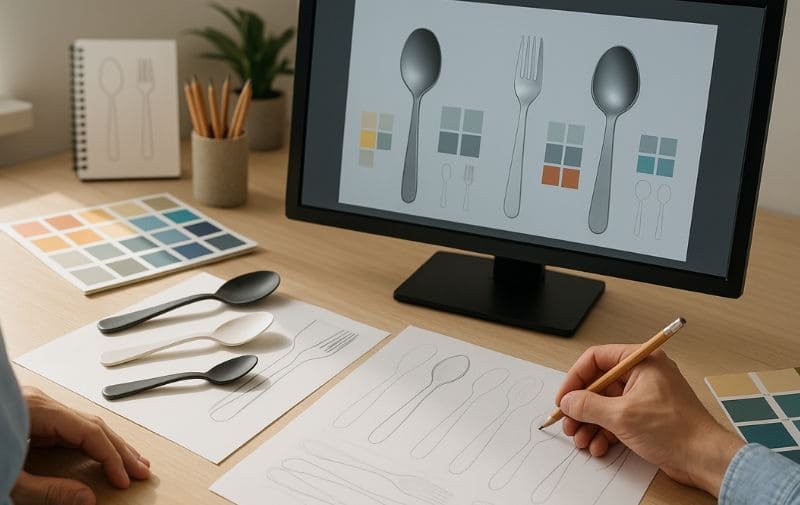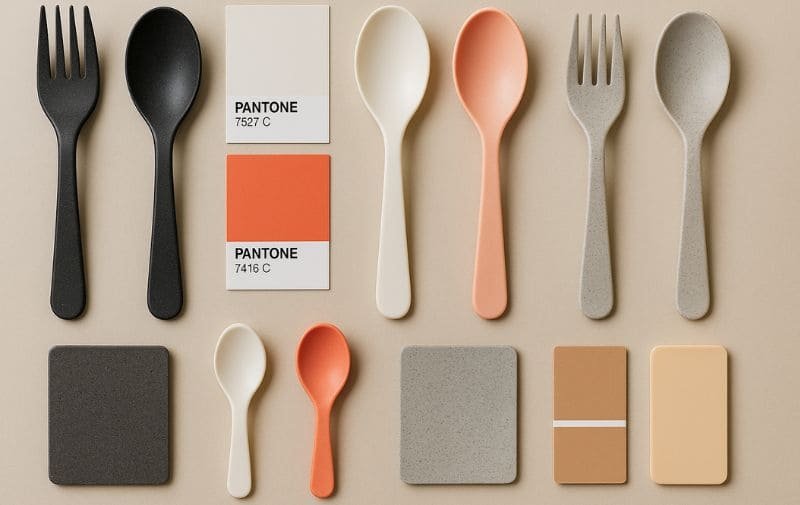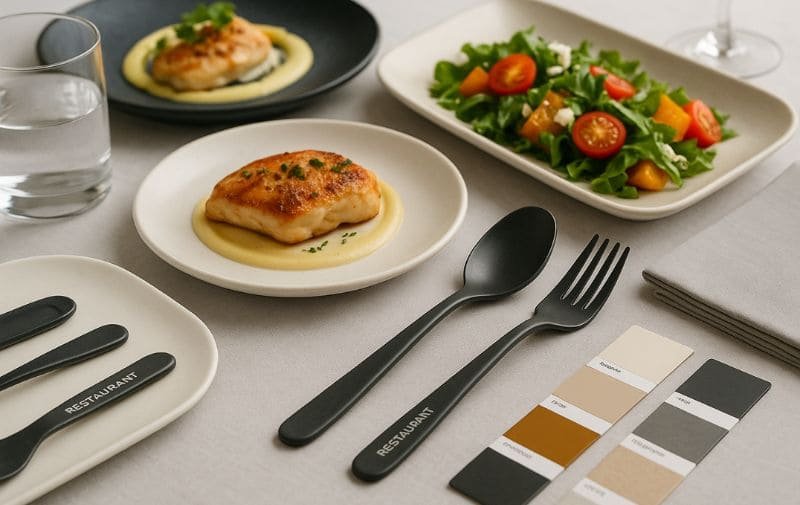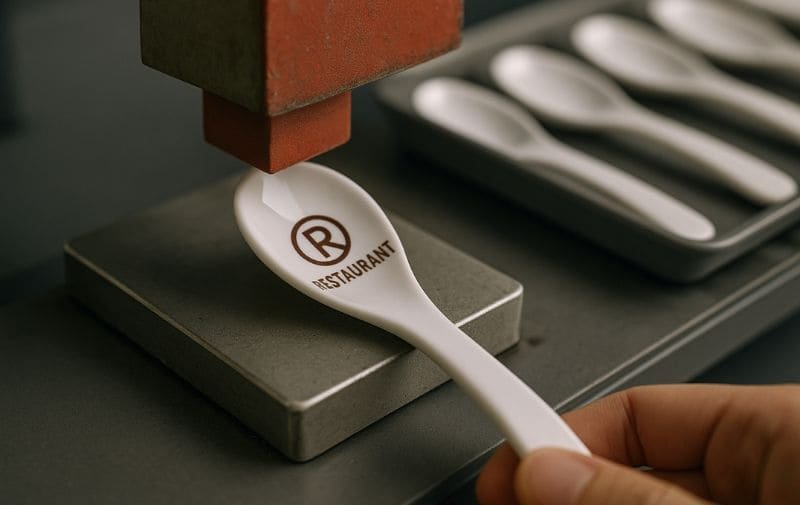You’re looking for a custom spoon or fork. It seems simple enough: a small utensil with your logo on it. But a spoon isn’t just a tiny shovel for food. It’s a lever, a piece of engineering that has to feel right in the hand and in the mouth, and a miniature canvas for your brand. Get it wrong, and you get a cheap-feeling, flimsy product that breaks and reflects poorly on your business.
To customize melamine spoons and forks, you must understand the engineering behind utensil stress points, the manufacturing reasons for high MOQs, and the art of designing for a small, curved surface. The key is to partner with a factory that insists on A5-grade material for safety and mouth-feel, and can guide you through the complexities of polishing, packaging, and shipping.
I’ve seen countless projects succeed or fail based on details most people never even think about. This guide will take you beyond the basics. We’ll explore the hidden physics of utensil design, the paradox of polishing, and the shipping traps that catch so many new importers. Let’s make sure your custom spoon is not just a utensil, but a statement of quality.

Last Updated: Oct 25th 2025 | Estimated Reading Time: 12 Minutes
What is the Most Critical Starting Question? (Let’s Talk MOQ)
Before you fall in love with a design, you have to face the most common hurdle in custom manufacturing: Minimum Order Quantity (MOQ). For a product as small as a spoon, the numbers can seem surprisingly high.
The standard MOQ for custom melamine spoons and forks is often 5,000+ pieces, especially for custom colors. This is not due to the spoon itself, but the massive setup time and material waste required to switch a production machine to a new custom color, making small runs uneconomical.
The Color Conundrum: Why Your Custom Color Costs More Than the Spoon
Imagine a factory is producing white spoons. To switch to your custom blue, the entire system—the mixer, the hopper, the feeding tubes—must be completely disassembled, cleaned, and purged with the new blue material to avoid any contamination. This process can take hours and waste 10-20kg of raw material. Because of this huge fixed cost for setup, no factory can afford to do it for just 500 pieces.
| Scenario | Typical MOQ | Why? |
|---|---|---|
| Ordering a Standard White Spoon | 1,000 – 3,000 pcs | The factory is already running white. Your order can be added easily with minimal setup. |
| Ordering a Custom Color Spoon | 5,000 – 10,000 pcs | The high cost of machine cleaning and material purging must be spread across a large number of units to be profitable. |
Insider Tip: If you need a smaller quantity (1,000-2,000 pieces), your best strategy is to design your custom print on a standard white or black spoon. This sidesteps the custom color MOQ issue entirely, as the customization comes from the printed decal, not the base material color.
What Material Must I Insist on for Safety and Quality?
For any item that goes into a customer’s mouth, there is no room for compromise. The material choice is about more than just food safety; it’s about the entire sensory experience.
You must insist on 100% food-grade A5 melamine. This is the only choice for ensuring the utensil is safe, durable, and has the premium, glass-like finish required for a pleasant “mouth-feel.” Cheaper materials feel gritty and can retain flavors.
Why Food-Grade A5 Melamine is the Unquestionable Standard
A5 is 100% pure, food-grade melamine resin. It is the globally recognized standard for high-quality, food-contact dinnerware, mandated by bodies like the US FDA and European LFGB. Its importance, however, goes far beyond a safety certificate.
The Ergonomics of the Mouth: The Science of “Spoon-Feel” The edge of the spoon is the most intimate point of contact with your customer. The brain is incredibly sensitive to the texture and shape of objects in the mouth. The quality of this “spoon-feel” is a direct result of the material and the finishing process.
- Material Density: A5 melamine has a satisfying heft and density that mimics ceramic, signaling quality. Cheaper materials like A1 are lighter and feel flimsy.
- Surface Finish: A5 can be polished to a glass-like, completely non-porous finish. Your tongue can instantly detect a gritty or porous surface from inferior materials, which can also retain flavors and stains from foods like tomato sauce or coffee.
- Thermal Properties: A5 melamine is an excellent insulator. It won’t get dangerously hot in soup or unpleasantly cold in ice cream, providing a more comfortable eating experience.
The Rise of Bamboo Fiber: The Eco-Aesthetic Choice
Bamboo fiber utensils, typically a composite of 30-40% bamboo powder and 60-70% melamine resin, are a fantastic choice for brands targeting an eco-conscious demographic.
- The Appeal: They offer a unique, slightly matte texture that feels warm and organic. The bamboo fibers create a subtle, natural flecking in the material, which is very popular in cafes, health-food brands, and modern children’s products.
- GEO/Regional Considerations: It’s crucial to be aware of your target market’s regulations. While widely accepted in the United States, Canada, Australia, and most of Asia, the European Union has placed specific restrictions on the import of bamboo-melamine composite food-contact items. Always verify the latest regulations for your specific country.
| Material Comparison | A5 Melamine (100%) | Bamboo Fiber Composite |
|---|---|---|
| Texture & Finish | High-gloss, smooth, ceramic-like. | Matte or semi-matte, organic, slightly textured. |
| Best Use Case | The universal professional standard. Ideal for restaurants, healthcare, retail, and corporate branding. | Cafes, health-food brands, children’s products, eco-conscious promotions. |
| Color Vibrancy | Excellent. Produces bright, saturated, and pure colors. | Muted, earthy tones. Colors will have a softer, more natural appearance due to the bamboo fibers. |
| Key Misconception | It is “unbreakable.” It is highly break-resistant, but can chip or break if dropped on a hard surface from a height. | It is “biodegradable.” Because it is bound with melamine resin, it is not biodegradable. Its eco-benefit is its use of a renewable resource. |
The Prototyping Process: From Digital Mockup to Physical Sample
Approving a physical sample is the most critical checkpoint in the entire process. It is your insurance policy.
- The Digital 3D Mockup: After you submit your vector artwork (
.ai,.eps), the factory’s design team will create a 3D rendering of the utensil with your design applied. This is your chance to check placement, size, and scale. For bowls and curved surfaces, this is where you will see the “pre-distorted” artwork. - The Physical Pre-Production Sample: Once you approve the mockup, the factory will produce a small number of physical samples. This costs around $100-$150 to cover the mini-decal setup and express shipping. Do not skip this. This is your only chance to:
- Verify the final Pantone color match in real-world lighting.
- Feel the weight, balance, and “spoon-feel” in your hand.
- Confirm the sharpness and clarity of your printed design.
- Test its durability yourself.
- Providing Feedback: If the sample isn’t perfect, provide clear, specific feedback with photos. “The blue is too dark” is better than “the color is wrong.” “The logo needs to be 2mm lower” is better than “the placement is off.” The approved sample becomes the “Golden Sample,” the master standard against which your entire production run will be measured.
How Does Custom Printing on a Small Utensil Actually Work?
You can’t just stamp a logo onto a melamine spoon. The process is far more sophisticated, designed to create a permanent design that will never peel, fade, or wash off.
The design is not silk-screened. It is printed onto special melamine decal paper, which is placed in the mold with the raw material. Under intense heat and pressure, the decal fuses with the spoon, becoming an integral part of the plastic itself. This allows for detailed, full-color designs.

The Miniature Canvas: Maximizing Impact on a Tiny Surface
A spoon handle is a long, thin, curved canvas. A standard square logo often looks awkward or squashed. A great design works with the shape of the utensil, not against it.
Strategic Design Placements:
| Placement | Best For | Design Tip |
|---|---|---|
| Handle End | Subtle corporate branding, restaurant logos. | Use a single, elegant icon or a vertically oriented wordmark. |
| Full Handle Wrap | Bold retail products, kids’ utensils. | A repeating pattern that follows the handle’s curve is more effective than a single static image. |
| Inside the Spoon Bowl | Children’s character spoons, promotional items. | This is the most impactful placement for kids, a “surprise” at the end of a bite. It requires the highest level of skill to apply the decal perfectly. |
The Invisible Details That Define a Premium Utensil
Beyond the obvious choices of material and printing, there are two hidden stages of production that separate a high-quality utensil from a cheap one: engineering and polishing.
A great custom spoon is engineered to withstand stress at its “neck” and polished to remove any trace of the molding process. These invisible steps determine the product’s durability and feel.
The Physics of Failure: Beyond Shape to Structural Integrity
A spoon is a lever. When you scoop hard ice cream, all the force concentrates where the handle meets the head. A fork’s tines are tiny levers.
- A cheap design will have a uniform thickness, creating a weak point at the neck that is prone to snapping.
- An engineered design subtly thickens this neck area or uses a specific curve (a fillet) to distribute the load, making it dramatically stronger. The thickness and taper of a fork’s tines are likewise engineered to prevent them from breaking under pressure.
The Polishing Paradox
Every molded spoon has a “parting line” or “flash”—a tiny ridge of material where the two halves of the mold met.
- A low-cost factory will tumble the spoons in a barrel to dull the sharp edge. This leaves the line visible and can scuff the finish.
- A high-quality factory uses a multi-stage process, often ending with hand-polishing to make this line completely imperceptible to the touch. This labor-intensive step is the ultimate sign of a premium product.
What Are the Typical Size Options?
Melamine utensils are not one-size-fits-all. The right dimensions depend entirely on the end-user.
| Utensil Type | Typical Length | Key Characteristics |
|---|---|---|
| Children’s Spoon/Fork Set | 13-15 cm (~5.5 in) | Shorter, thicker handles for small hands. Spoon bowl is rounder and shallower. |
| Dessert / Teaspoon | 14-16 cm (~6 in) | Smaller bowl, more delicate design. |
| Soup Spoon (Asian Style) | 16-18 cm (~6.5 in) | Deep, round bowl with a thick, curved handle. |
| General Adult Spoon/Fork | 18-20 cm (~7.5 in) | Longer handle, standard oval spoon bowl, or 3-4 tine fork. |
Can I Choose Eco-Friendly Packaging?
Absolutely. As consumers become more environmentally conscious, moving away from single-use plastics is a smart branding decision.
Standard packaging is often an individual polybag, which is not eco-friendly. You can opt for alternatives like paper bands, glassine bags, or simply bulk packing the utensils. For retail, custom-printed paper boxes are available, usually with an MOQ of 1,000-3,000 boxes.
What Is the Smartest Way to Ship a Lightweight Product?
For heavy items like plates and bowls, sea freight is the only logical choice. But for lightweight spoons and forks, the calculation changes.
Due to their low weight, air freight or express couriers (like DHL/FedEx) can be a surprisingly cost-effective and much faster option than sea shipping for small-to-medium sized orders of spoons and forks. However, you must be aware of “dimensional weight.”
The Weight vs. Volume Puzzle: A Hidden Shipping Cost
A box containing 2,000 spoons is large but very light. Shipping carriers charge based on whichever is greater: the actual weight of the box, or its dimensional weight (a calculation based on its size). For bulky, light items, the dimensional weight can be 2-3 times the actual weight, leading to surprise charges.
Crucial Tip: When you get a shipping quote, you must ask the supplier: “Does this quote account for the final dimensional weight of the master carton?” This single question will protect you from unexpected shipping bills.

Conclusion
A custom melamine spoon or fork is a statement. It’s an engineered tool designed for safety and durability, a sensory object defined by its feel, and a miniature billboard for your brand. By understanding the details—from material science to the physics of failure—you can partner with a manufacturer to create a product that truly elevates your customer’s experience.
Frequently Asked Questions (F.A.Q.)
1. Can you match a specific Pantone color for my spoons?
Yes, a high-quality melamine spoon manufacturer can match any Pantone (PMS) color. However, because this requires a full production line clean-out (the “Color Conundrum”), this will always be subject to a high MOQ, typically 5,000 pieces or more per custom color.
2. Are custom melamine spoons and forks dishwasher safe?
Absolutely. Properly manufactured A5 melamine utensils are designed for the rigors of both commercial and residential dishwashers. The design is fused into the material and is permanent; it will not fade, peel, or scratch off during washing.
3. Is there a mold cost for creating a custom spoon shape?
Yes. If you use one of the factory’s hundreds of existing shapes, there is no mold cost. If you wish to create a completely unique, proprietary shape, there will be a one-time mold development fee, normally $800 to $900 USD, depending on its complexity.
4. What is the typical full timeline for an order of 2,000 custom spoons?
From final design approval to your door (via air freight): Prototyping and sampling (2 weeks), mass production (4-5 weeks), and air shipping (1-2 weeks). Plan for a total of 7-9 weeks. If using sea freight, add another 4-6 weeks for shipping.
5. What is the expected lifespan of a high-quality melamine utensil?
With proper care (avoiding harsh abrasive scrubs and microwave use), a high-quality A5 melamine spoon or fork can last for many years in both residential and commercial use. Its durability and longevity are key selling points over more fragile or disposable alternatives.
6. Are there any design limitations I need to know about?
The primary limitation is the inability to print true metallic colors like gold or silver, as the process does not use metallic inks. Additionally, extremely fine text (below 6pt font) or hyper-detailed lines can lose clarity and are not recommended for the best results on a small, sometimes curved surface.
Recommended Internal & External Links:
How to Design & Source Custom Melamine Bowls
FDA – Food Contact Substance Notification Program (Authoritative source on food safety in the USA)
European Food Safety Authority (EFSA) – Food Contact Materials (Authoritative source on food safety in the EU)


